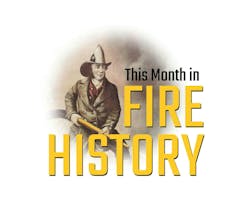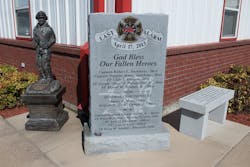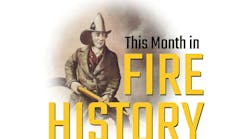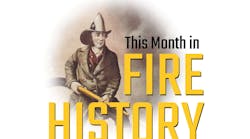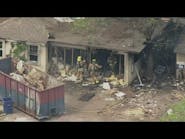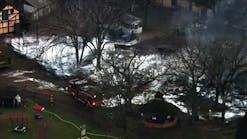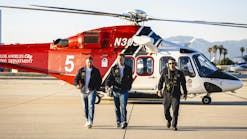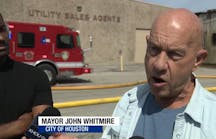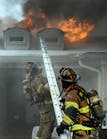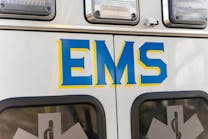April is a wonderful time of year. Spring has sprung. The weather is getting warmer. Baseball is back. The NBA and NHL playoffs are beginning. The NFL Draft is here. The sun is shining until after 7 p.m. What's not to like about April?
Of course, April also brings Tax Day! And it also brings memories of some of the most horrific events the fire service has had to face. From deadly fires to terrorist attacks to natural disasters, April has seen it all.
April 4, 1949, Effingham, IL—St. Anthony’s Hospital fire
On April 4, 1949, a nurse at St. Anthony's Hospital in Effingham, IL, alerted the hospital staff to the smell of smoke. It was speculated that a fire may have started in a wooden laundry chute, potentially from a smoldering cigarette that was gathered up with patient bedding and tossed down the chute.
Shortly before midnight, a massive fire broke out, spreading rapidly through the building.
The combination of the combustible building materials and lack of fire safety features like sprinklers and alarms allowed the fire to spread rapidly through the hospital once it started.
Oxygen and ether tanks in a basement storage area also exploded, further fueling the blaze.
The hospital had no fire alarm system.
According to a story on the University of Illinois Urbana-Champaign website, the Effingham Volunteer Fire Department arrived within 10 minutes of the first call, but by that time the fire had already burned through the hospital roof. Rescue efforts were further impeded as the small department had only three engines. Until mutual aid departments arrived on scene hours later, the firefighters had no ladder truck or other aerial apparatus to use to rescue victims from the upper floors.
With the assistance of 11 mutual aid departments, firefighters were able to keep the fire from spreading elsewhere, but the hospital was virtually destroyed. A total of 76 people tragically lost their lives. The victims included patients, nurses, nuns, and a priest.
April 15, 2013, Boston, MA—Boston Marathon bombing
On April 15, 2013, four hours after the start the Boston Marathon, two improvised explosive devices (IEDs) were detonated among the spectators approximately 100 to 200 yards from the finish line. The first explosion occurred at 2:50 p.m. and the second followed 10 seconds later. There were 26,893 official entrants, and more than 500,000 people gathered along the marathon route
Three people died, including an 8-year-old, 281 people were injured, and 127 patients received care at the participating trauma centers on that day.
A temporary medical tent had been erected at the finish line to provide care for up to 2,500 runners for general heat- and other-related injuries. The tent was staffed with paramedics, physicians, nurses, and physical therapists. Boston EMS crews were stationed at the tent to transport approximately 200 to 250 runners who may need further medical attention to the Boston area hospitals. These staffers played a critical role in assisting with the rescue and treatment of victims.
Firefighters were on scene near the finish line and provided immediate aid by applying tourniquets using bandages and belts to those with severe injuries. Their quick actions were instrumental in saving lives, as they worked swiftly to treat victims and dismantle barriers for access.
The coordinated efforts of the fire department, along with other agencies and responders, were crucial in managing the aftermath of the bombings and ensuring that victims received prompt medical attention and care.
April 17, 2013, West, TX—West, TX, Fertilizer Company Explosion
“On April 17, the ground shook in West, TX. It collapsed buildings and broke hearts.”
That’s what a solemn Chief Ron Siarnicki, then executive director of the National Fallen Firefighters Foundation, told more than 10,000 people at a memorial service in Waco in 2013.
On April 17, 2013, the West Fire Department responded to a call of fire at the West Fertilizer Company. While on scene, an ammonium nitrate explosion occurred. The explosion killed 15 people, injured more than 160 people and damaged or destroyed more than 150 buildings, including homes, schools, and a nursing home. The blast created a 93-foot-wide crater at the site.
Ten firefighters perished while trying to quell the flames, the most firefighters killed during a single incident since the terrorist attack on the World Trade Center on 9/11.
Killed in blast were West Firefighters Doug and Robert Snokhous, Morris Bridges, Cody Dragoo and Joey Pustejousky; Kenny Harris of Dallas Fire-Rescue; Jerry Chapman and Cyrus Reed of the Abbott Fire Department and West EMS; Perry Calvin of the Merkel Fire Department and Kevin Sanders of the Bruceville Eddy Fire Department and West EMS. Two civilians who jumped into action to help – Jimmy Matus and Buck Uptmor – were made honorary West firefighters.
The federal Bureau of Alcohol, Tobacco, Firearms and Explosives and the Texas fire marshal’s office later ruled that someone deliberately started the fire that triggered the fatal explosion.
Five years later, the West Fire Department had started implementing 11 recommendations from a 55-page report from the state fire marshal.
April 18, 1906, San Francisco, CA—Great San Francisco Earthquake
The earthquake of April 18, 1906, began to roar at 5:12 on a clear Wednesday morning, just at sunrise. It was one of the most severe shakings in history, estimated to be an 8.0 on today’s Richter scale, and it rumbled on for about 45 full seconds.
The earthquake destroyed over 28,000 buildings and sparked massive fires that burned for four days, leveling over 500 city blocks. The death toll is estimated to have exceeded 3,000 people, making it the deadliest earthquake in U.S. history at the time. Around 250,000 were left homeless.
On the 100th anniversary of the great quake, the late Firehouse founder, Dennis Smith wrote an article, The Greatest Fire Alarm In American History that found the answer to the question of who saved San Francisco: The firefighters.
Smith reported that, “The fire department of San Francisco—its 584 men, 38 steam engines, 10 hook and ladders, eight chemical pumpers, 39 hose wagons, and 323 horses—was brought, in the first minute after the shaking, to the absolute limit of its capacity to operate.
“Also in that first minute, perhaps the greatest tragedy of all occurred, for one of the most respected fire chiefs in the United States was rendered unconscious and would die four days later. It was an event that would have terrible consequences for the gem city of the Pacific.”
April 19, 1993, Waco, TX—Religious group complex fire
On February 28, 1993, agents from the United States Bureau of Alcohol, Tobacco and Firearms (ATF) raided the compound of the Branch Davidians religious sect in Waco, TX. This led to a shootout between the ATF and the Branch Davidians, resulting in the deaths of four ATF agents and six Branch Davidians.
After the initial raid, a 51-day standoff ensued. The FBI attempted several ways to force the Branch Davidians to surrender.
On April 19, 1993, the FBI launched a tear gas attack. Shortly after, a fire broke out in the compound, and 76 of the 85 Branch Davidians, including religious group leader David Koresh and 25 children, were killed.
The cause of the fire remains highly disputed, with some arguing the Branch Davidians set it themselves, while others believe the tear-gas attack started the blaze.
April 19, 1995, Oklahoma, City, OK—Alfred P. Murrah Federal Building
At 9:02 a.m. on April 19, 1995, a massive truck bomb containing over 4,800 pounds of explosives detonated in front of the north side of the nine-story Alfred P. Murrah Federal Building in Oklahoma City, OK. The blast killed 168 people, including 19 children, and injured more than 850 others. One-third of the building was destroyed, and the explosion created a 30-foot-wide, 8-foot-deep crater on the street next to the building. The force of the blast damaged 324 surrounding buildings, overturned cars, and shattered windows in a 50-block radius.
The attack was carried out by Timothy McVeigh, a U.S. Army veteran, who was angry at the federal government over the Waco siege in 1993. It remains the deadliest act of domestic terrorism in U.S. history.
When the bomb exploded, the Oklahoma City Fire Department responded, clearing debris, providing medical triage, and conducting a thorough search of the damaged building. The search continued into the next day.
Twenty years later, in an article America Pauses to Remember Oklahoma City Bombing Victims on Firehouse.com, retired FBI agent Danny Defenbaugh detailed how his work led to the arrest of McVeigh.
April 19, 1904, Toronto, Canada – Great Toronto Fire
Around 8:04 p.m. on April 19, 1904, a police constable spotted flames rising from the elevator shaft of the E & S Currie Limited's neckwear factory at 58 Wellington Street West. Strong winds and cold weather helped fan the flames.
Seventeen fire halls responded, with more than 250 firefighters from Toronto and surrounding communities like Hamilton, Buffalo, and London, to battle the blaze, but despite their efforts, the fire continued to spread, destroying around 100 buildings across 20 acres of downtown Toronto's industrial and commercial core.
The fire took nine hours to get under control. The glow of the fire could be seen for miles in all directions.
The fire caused an estimated $10.4 million in damage (equivalent to $337 million today) and left 5,000 people temporarily or permanently out of work.
Miraculously, there was only one fatality.
The only building that survived was the Kilgour Brothers factory, which had a sprinkler system that prevented the fire from spreading further north.
April 23, 1940, Natchez, MS—Rhythm Nightclub Fire
On April 23, 1940, the Rhythm Night Club was going to come alive with a popular swing band from Chicago for a one-night performance. Nearly 750 people packed into the tiny 120-by-38-foot building.
As Michael Kuk described in his A Nightclub, A Fire...And a Generation Vanishes article in 2010, “It is commonly held that the fire began around 11 p.m. The exact cause could never be determined, as too many factors led investigators into a confused set of circumstances. Even though most agreed that the fire began close to the upfront hamburger stand, it was never pinpointed as the exact cause. What is agreed upon is the rapid spread of flames through the hanging Spanish moss, boosted by the application of the flammable insecticide. The fire quickly took in the large open area of the dance hall with flames everywhere.
“The visual horror of a severe fire burning overhead, coupled with oxygen-stealing smoke conditions, put the club's patrons in a state of pure panic," Kuk wrote. "Anyone trapped inside the Rhythm Night Club now had one thought — to escape and survive!”
The fatality count was 209, making the Rhythm Night Club America's second-highest loss of life in a nightclub-based incident, after the fire at Boston's Cocoanut Grove in Boston, MA, in 1942 that claimed 492 lives.
“The investigation of the fire proved a repeat of findings that fire officials were all too familiar with. Overcapacity with an improper number of exits headed the list. What openings did exist were not designed to open to the outside. Flammable decorations, in particular the Spanish moss, hung everywhere. No first-aid firefighting equipment was available.”
Other notable April fires
April 6, 1968, Richmond, IN - Marting Arms Sporting Goods explosions
April 10, 1917, Eddystone, PA - Eddystone Ammunition Company explosion
April 12, 2009, Houston, TX – Residential fire kills two ffs
